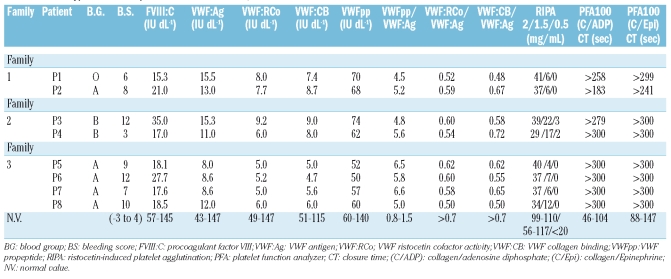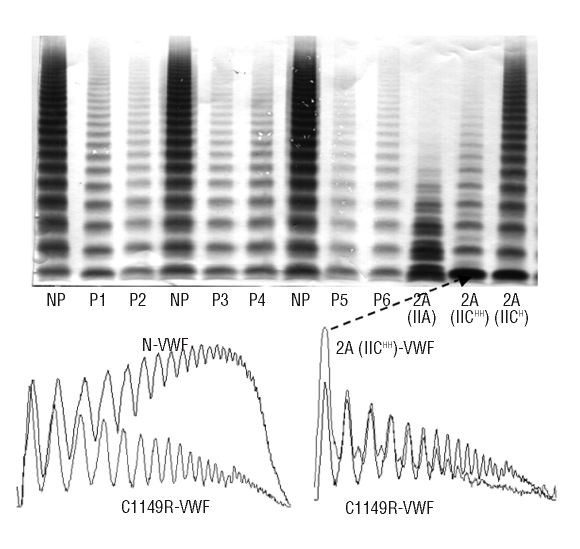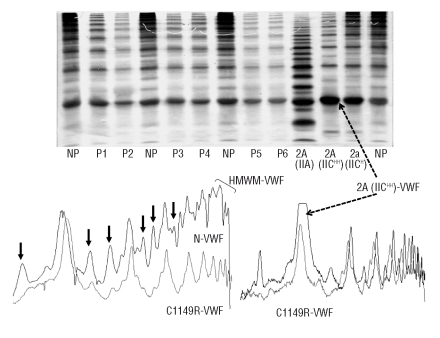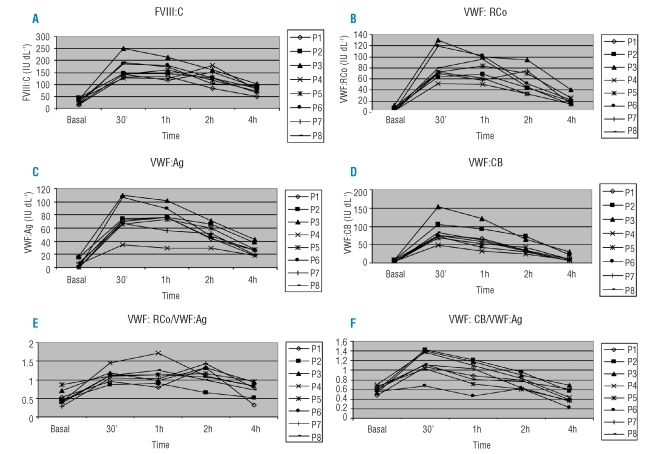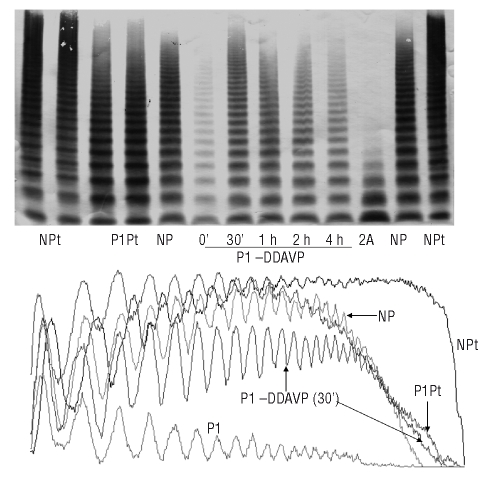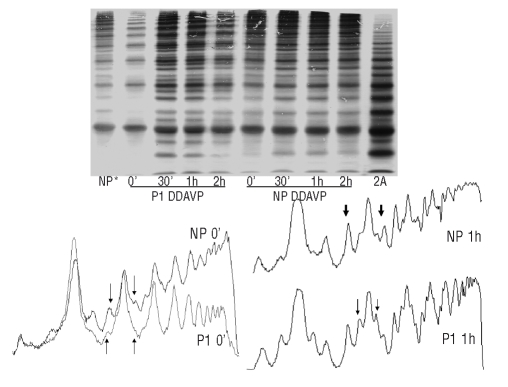The classification and even the diagnosis of von Willebrand disease continues to evolve. In this paper, the authors show how a detailed examination of difficult cases using clinical laboratory and molecular analyses can be used to reach a clinically useful conclusion. See related perspective article on page 610.
Keywords: C1149R von Willebrand disease, platelet von Willebrand factor, VWD type 2A (IIE), desmopressin, von Willebrand factor
Abstract
Background
Mutation C1149R in the von Willebrand factor (VWF) gene has been thought to cause autosomal dominant severe type 1 von Willebrand disease (VWD).
Design and Methods
Eight patients from three unrelated families with this mutation were included in the present study who had distinct VWF abnormalities, not described in earlier studies.
Results
The patients showed notably low levels of VWF antigen (VWF:Ag), VWF ristocetin cofactor activity (VWF:RCo), VWF collagen binding (VWF:CB), and a reduced ristocetin-induced platelet aggregation (RIPA). VWF:RCo/VWF:Ag and VWF:CB/VWF:Ag ratios were lower than 0.7. At basal conditions, all the VWF multimers were decreased in plasma, with a clearly lower relative proportion of the high molecular weight VWF multimers (HMWM). In high-resolution agarose gels, a large decrease in the relative proportions of the satellite bands was seen. The patients had a brief good response to desmopressin (DDAVP) administration, but the released VWF half-life was shorter than normal, indicating an accelerated clearance of their VWF. Platelet VWF was abnormal.
Conclusions
We conclude from the results obtained in these patients for plasma phenotypic data that this mutation should be classified as a VWD type 2A (IIE). DDAVP therapy may be somewhat helpful for this mutation, at least for mild to moderate bleeding. These data provide evidence that for VWD classification factors other than basal VWF, such as DDAVP response and platelet VWF, should be considered.
Introduction
Von Willebrand disease (VWD) is a bleeding disorder caused by inherited defects in the concentration, structure, or function of the von Willebrand factor (VWF).1,2 According to the updated revision for VWD classification, three categories are distinguished in a primary hierarchical level.3 Type 1 includes partial quantitative deficiencies, type 2 includes qualitative defects, and type 3 includes virtually complete deficiency of VWF. VWD type 1 plasma may contain mutant subunits of VWF, but has normal functional activity relative to antigen level. The proportion of large multimers is not decreased significantly.
VWD type 2 is divided on a secondary level in four VWD types according to different pathophysiological mechanisms: VWD types 2A, 2B, 2M and 2N. Type 2A includes variants with decreased platelet adhesion caused by selective deficiency of high-molecular-weight VWF multimers (HMWM). Type 2B includes variants with increased affinity for platelet glycoprotein Ib.
Type 2M includes variants with markedly defective platelet adhesion despite a relatively normal size distribution of VWF multimers. Type 2N includes variants with markedly decreased affinity for factor VIII (FVIII). Finally, additional tertiary information does mention the subtypes. Such information may include a VWF multimer pattern that suggests a specific disease mechanism (e.g. IIA, IIB, IIC, IID, IIE).
When sensitive assay methods are used, many patients with VWD type 1 have mild abnormalities of multimer structure or distribution. In most cases, therefore, a complex phenotype with features of both VWD type 2 and type 1 should be classified under type 2 in order to preserve a correlation with the response to desmopressin. In clinical practice, distinctions among these VWD types are not always easily made and the boundary between normal and abnormal phenotypes may be controversial or not sharply defined.4 The VWD caused by mutation C1149R was initially described as a dominant severe VWD type 1.5,6 The ISTH-SSC (International Society on Thrombosis and Haemostasis-Scientific and Standardization Committee) database for VWF mutation includes this mutation in the type 1 group (http://www.vwf.group.shef.ac.uk/).
Our study refers to 8 patients from three unrelated families with the autosomal dominat C1149R mutation who showed distinct abnormalities of VWF in platelets and in plasma following DDAVP administration. They had not been described in earlier studies and it reinforces the criteria that should be considered to be VWD type 2A (IIE).7,8
Design and Methods
Patients and controls
Eight patients from three unrelated families with the C1149R VWD mutation were studied. Fifty healthy individuals of either sex, with no known bleeding problems, and of an age range similar to the enrolled family members were used as control. All of the patients gave their informed consent for this study. The study was approved by the local Research Ethics Committee. The desmopressin response was tested in the 8 patients by intravenous administration of 0.3 μg/kg of DDAVP. Plasmas from patients with VWD types 2A (IIA) heterozygous for the I1568N mutation in exon 28 and patients with VWD type 2A (IIC) homozygous and heterozygous for the mutation F404insNP in exon 11 were included as controls.9,10
Bleeding score
Clinical bleeding history assessment was carried out by interview and completion of a questionnaire based on that originally proposed by the European Study MCMDM-1VWD11 (Table 1).
Table 1.
Phenotypic results of patients from families 1, 2 and 3.
Phenotypic analysis
Closure times (CT) were determined using the PFA-100® system (Platelet Function Analyzer, Dade International, Miami, USA) for collagen/ADP (C/ADP) and the collagen-epinephrine (C/Epi) cartridges. Procoagulant factor VIII activity in plasma was measured using a chromogenic assay (FVIII:C) and VWF antigen (VWF:Ag) levels were determined by ELISA. The von Willebrand factor ristocetin cofactor activity (VWF:RCo) test was performed on lyophilized platelets (Helena Biosciences Europe, Sunderland, United Kingdom) using an aggregometer. Ristocetin induced platelet agglutination (RIPA) was carried out in platelet-rich-plasma in an aggregometer (Helena Biosciences Europe, Sunderland, United Kingdom) with final concentrations of ristocetin of 2, 1.5 and 0.5 mg/mL. The VWF:CB level was determined with an in-house ELISA method that utilized Type I collagen purchased from Nycomed (Nycomed, Linz, Austria). VWF multimeric distribution was analyzed using high- and low-resolution SDS-agarose gel electrophoresis. Both the low-resolution and the high-resolution gels were run in an LKB Multiphor system, essentially as previously described.12,13 VWF multimers were transferred to Immobilon P membrane (Millipore, MA, USA) by electroblotting and the multimers were visualized using Extravidin-Alkaline Phosphatase-conjugated immunopurified anti-VWF polyclonal antibodies (Dako, Glostrup, Denmark). Densitometric analysis was performed using the ImageQuant program (General Electric, Fairfield, CT, USA). Densitometric profiles were compared between lanes located in the same gel. VWF propeptide (VWFpp) concentrations were determined with an ELISA test kit (SANQUIN, Amsterdam, The Netherlands).
Levels of FVIII:C, VWF:RCo, VWF:Ag, VWFpp, CT PFA-100 with C/ADP and C/Epi were tested before and after administration of DDAVP. Platelet VWF was measured as previously described,14 modified by using citrated blood in the presence of inhibitors (Protease Inhibitor Cocktail, Sigma-Aldrich, St. Louis, MO, USA) instead of acid-citrate-dextrose (ACD) anticoagulant and lysing with 1:40 v/v of 20% Triton X-100 as previously published15 instead of sonication. The half-life (t1/2) of VWF:Ag and VWFpp was determined according to a previously published method.16–18
Genetic analysis
Genomic DNA was isolated from peripheral blood leukocytes (Invisorb Spin Blood Mini Kit, Nucliber, Berlin, Germany). The promoter, all 52 exons and intron-exon boundaries were amplified by polymerase chain reactions (PCR) in a GeneAmp PCR System 9700 (Applied Biosystem, Forster City, CA, USA). The primers used for this study were those described in the MCMDM-1VWD Study.19 The oligonucleotide primers used for polymerase chain reaction PCR amplification of exon 26 were CAA CAT TAT CTC CAG ATG GC (forward primer) and TTG CAG GTC AGA GAT AGG AC (reverse primer). The PCR products were purified using the Qiaquick PCR purification kit (QIAGEN, Hilden, Germany). Both forward and reverse strands were directly sequenced by using an automated Applied Biosystems 3130 sequencer (Applied Biosystem, Forster City, CA, USA).
Results
All 8 patients showed notably decreased VWF antigen and activity as well as reduced RIPA and VWF:RCo levels (Table 1). The VWF:RCo/VWF:Ag ratio and the VWF:CB/VWF:Ag ratio were lower than the 0.7 normal range indicating a VWD type 2. Baseline data showed that all the plasma VWF multimers were decreased, with a clearly lower relative proportion of HMWM, compared to normal plasma (Figure 1).
Figure 1.
Multimeric analysis of plasma von Willebrand factor (VWF). Upper panel: multimeric analysis of VWF in low resolution (1.2%) SDS-agarose gel in plasmas of a normal subject (NP), patients with the missense C1149R mutation (P1 to P6), and in plasma of a patient with VWD type 2A(IIA) VWD and patients with VWD type 2A(IIC) homozygous (HH) and heterozygous (H). Lower panel: densitometric analysis comparison of the profiles from the upper panel normal. A large decrease in relative proportion of high molecular weight VWF multimers (HMWM) is evident in all the patients with this mutation. Densitometric profiles of the remaining patients are similar to that of P1. The type 2A (IIC) pattern shows an aberrant multimeric pattern with a clear increase in the relative proportion of the smallest oligomer (discontinuous arrow), not present in the C1149R VWF.
On high-resolution agarose gel, a markedly decreased proportion of the satellite bands was observed (Figure 2). The increase in the relative proportion of the first oligomer characteristic of VWD type 2A (IIC) was not seen in the patients. Two hours after the administration of DDAVP, all plasma levels of FVIII:C, VWF:RCo, VWF:Ag and VWF:CB had increased more than threefold over baseline (Figures 3A, B, C and D). The t1/2 of released VWF was shorter (range 1–1.5 h) than normal (Table 2). Interestingly, the mean t1/2 value of VWFpp after DDAVP administration in the patients was 100 min (range: 85–115 min) which is shorter than that previously reported in normal individuals (2–3 h).16–18 Some temporary correction of VWF:RCo/VWF:Ag and VWF:CB/VWF:Ag ratios was observed (Figures 3E and F). Noticeable quantitative differences were seen among the three families of patients. The platelet VWF (VWF:Ag and VWF:RCo) content in the 8 patients studied was within the normal range (0.14–0.50 IU/109 platelets). All the control subjects analyzed displayed normal VWF multimers in platelet VWF with super-large VWF multimer present (Figure 4). In contrast, patients with this mutation had a qualitatively abnormal content of VWF showing a very decreased relative proportion of the super-large HMWM.
Figure 2.
Multimeric analysis of plasma von Willebrand factor (VWF). Upper panel: multimeric analysis of VWF in higher resolution (2%) SDS-agarose gel in plasmas of a normal subject (NP), patients with the missense C1149R mutation (P1 to P6), a patient with VWD type 2A(IIA) VWD and patients with VWD type 2A(IIC) homozygous (HH) and heterozygous (H). Lower panel: densitometric analysis comparison of: to the left, a normal VWF and the C1149R VWF; to the right, the 2A(IICHH) and the C1149R VWF. A large decrease in relative proportion of the outer satellite bands is noticeable in all the patients compared to the normal subject (indicated by arrows). The type 2A (IIC) pattern shows an aberrant multimeric pattern with a clear increase in the relative proportion of the smallest oligomer (discontinuous arrow), not present in the C1149R VWF.
Figure 3.
Responses to desmopressin (DDAVP) in 8 patients with the von Willebrand factor (VWF) C1149R mutation. Changes are shown for each patient before and at 30 min, one hour, two hours, and four hours (30’, 1h, 2h, 4h) after the end of infusion of DDAVP. Panel A: procoagulant factor VIII (FVIII:C) (IU dL−1). Panel B: von Willebrand factor ristocetin cofactor activity (VWF:RCo) (IU dL−1). Panel C: von Willebrand factor antigen (VWF:Ag) (IU dL−1). Panel D: von Willebrand factor collagen binding (VWF:CB) (IU dL−1). In all patients, FVIII:C, VWF:RCo, VWF:Ag and VWF:CB levels rose significantly 30 min after DDAVP administration. Panel E: A significant rise in the VWF:RCo/VWF:Ag ratio is seen at one hour after DDAVP administration in all patients. This increase was much more pronounced in patient P4. Panel F: it is noticeable that VWF:CB behaves quite similarly to VWF:RCo after DDAVP administration.
Table 2.
Factor VIII (FVIII) and von Willebrand factor (VWF) measurements before and after desmopressin (DDAVP) treatment in patient P1. DDAVP induced a 5-fold increase of VWF:Ag, a 10-fold increase of VWF:RCo and VWF:CB and a 6.4 to 9.2 fold increase of FVIII:C followed by decreased half-life times of all VWF parameters and FVIII:C consistent with or even pathognomonic for VWD type 2A (IIE) . There is change from type 2 to type 1 phenotype with transient correction of PFA CT using sensitive tests for functional VWF tests and platelet function.
Figure 4.
Multimeric analysis of von Willebrand factor (VWF) in platelets and plasma of a patient with C1149R mutation. DDAVP response. Upper panel: multimeric pattern of VWF in low resolution (1%) SDS-agarose gel in platelet lysates of a normal individual (NPt) and patient (P1Pt), as well as in plasma in a normal subject (NP) and in the patient before (0’) and after DDAVP administration at 30 min, one hour, two hours, four hours (30’, 1h, 2h, 4h). Plasma of a patient with 2A VWD (IIA) is included as a control. Platelet VWF in the patient shows an absence of the super-large HMWM of VWF decrease in the relative proportion of HMWM compared with a normal subject. Plasma VWF from the patient at basal state presents a decreased relative proportion of the HMWM compared to patient platelet VWF. Lower panel: densitometric analysis of the lanes from the gel. Super-large high molecular weight multimers HMWM (bar with arrow) are present in normal platelets but not in the corresponding normal plasma. After DDAVP therapy, a transient increase of the HMWM is observed in the patient plasma, with no appearance of the super-large multimers HMWM of VWF. The remaining patients showed a similar response and pattern. Type 2A (IIA) VWF shows the lack of HMWM.
Following DDAVP administration, the relative proportion of HMWM normalized temporarily in the low resolution gels was seen. However, it should be emphasized that following its administration super-large HMWM were not seen in any of the patients (Figure 4) in contrast to their appearance in normal subjects as previously described.20 In the high resolution gels, a temporary increase in the relative proportion of the satellite bands was discernable, although striking differences from the response seen in normal subjects was evident. Thus, after DDAVP administration in the patients the inner VWF multimeric satellite bands showed an increased relative proportion higher than that seen in normal subjects (Figure 5).
Figure 5.
DDAVP responses in plasmas of a normal subject and a patient with C1149R mutation. Upper panel: multimeric pattern of VWF in high resolution (2%) SDS-agarose gel in plasmas of a normal individual (NP) and a patient (P1) before (0’) and after desmopressin (DDAVP) administration at 30 min, one hour, two hours (30’, 1h, 2h), respectively. Lower panel: densitometric analysis of the multimeric profiles from the upper panel, before and after DDAVP administration. Before DDAVP (left) a marked relative decrease in the proportion of outer satellite bands is noticeable in the patient compared to the normal subject (indicated by thin arrows). After DDAVP (right) a clear increase in the relative proportion of the inner satellite bands (thin arrows) is visible in the patients, in contrast to the increase of the outer satellite bands seen in the normal subject (thick arrows). Again, the remaining patients showed a similar response and pattern. Type 2A VWF shows the characteristic increase of the outer satellite bands. It clearly shows a change in VWF multimers after DDAVP consisting of a mixture of normal VWF and mutant VWF, but the combination, a mixture of mutant and normal VWF, is featured by rapid clearance in vivo. This observation is pathognomonic for VWD 2A (IIE).
All affected individuals from the three families had an increased VWFpp/VWF:Ag ratio before and after DDAVP administration (Table 1 and 2).
We determined the entire coding sequence of the VWF gene21 in the 8 patients. In addition to several polymorphisms, we identified only one candidate mutation, 3445T>C in exon 26, which predicts an amino acid change, Cys1149Arg. Both nucleotides T and C were detected in this position, indicating that only one allele was the carrier for the mutation, as would be expected for a heterozygous state.
Discussion
The mutation Cys1149Arg (3445T>C) of the VWF gene was first described as causing severe VWD type 1 with high penetrance.5 The ISTH VWF mutation database (www.vwf.group.shef.ac.uk) still includes this mutation as VWD type 1. A study of the expression of the corresponding mutant recombinant VWF (C386R) demonstrated a reduced secretion and intracellular retention of normal VWF, creating a dominant negative defect.5,6 Defects in multimer assembly can be caused by heterozygous mutations in the D3 domain that interfere with intersubunit disulfide bond formation in the Golgi. This phenotype was initially designated VWD type IIE, first described in a family with aberrant multimeric pattern of VWF. It is like IIC but a marked increase in the smallest oligomer, a hallmark of type IIC, was not present (Figures 1 and 2).9,22 VWD type 2A (IIE) share in common with VWD type 2A (IIC) a reduced proteolysis of plasma VWF with a large decrease in the relative proportion of the outer satellite bands. By contrast, VWD type 2A (IIA) has an intense proteolysis of VWF visible by a higher proportion of the outer satellite bands of the triplet structure (Figures 2 and 5).
In our study the mutation C1149R was identified in 8 patients from three unrelated families and we found some different phenotypic results from those previously reported. Baseline plasma levels of VWF:Ag were diminished, with VWF:RCo/VWF:Ag and VWF:CB/VWF:Ag ratios <0.7 and decreased platelet adhesion caused by selective deficiency of HMWM and intermediate molecular weight VWF multimers (IMWM). This suggests a VWD type 2A (Figure 1). A clearly relevant decrease in the relative proportion of the outer satellite bands was also evident (Figure 2), with a pattern of VWD type 2A (IIE). A qualitative abnormal platelet VWF was observed in contrast with the results of previous expression studies that showed a synthesis of an almost fully normal VWF5,8 (Figure 4). However, the quantitative platelet VWF content seen in this study may support the platelet retention of this molecule suggested by these earlier expression studies.
Accelerated clearance can also be involved in dominant VWD type 1 contributing to the low plasma VWF levels. According to the criteria recommended by Federici et al.23,24 the patients in this study had a good response to DDAVP infusion, although the t1/2 of VWF was short (range 1–1.5 h) when compared with normal controls, as already reported by other authors.7,8,25–27 These patients also exhibited an increased plasma VWFpp/VWF:Ag ratio (a surrogate marker for VWF clearance), indicating an accelerated clearance of the endogenously produced VWF (Table 1).17,18,28 DDAVP was clinically effective in those patients, although we did not have the opportunity to evaluate the efficacy of DDAVP therapy in situations with a high risk of bleeding.
An intriguing aspect of the patients presented here is the temporary correction of the VWF:RCo/VWF:Ag ratio and the low resolution multimeric pattern of VWF after DDAVP, which in fact would suggest more a type 1 characteristic not described in classical type 2A, although it occurs very briefly becoming abnormal when VWF: Ag is still higher than the basal values. Furthermore, the abnormal proteolytic pattern seen after DDAVP administration reinforces its consideration as VWD type 2. However, it must be emphasized that platelet VWF is not completely normal as it occurs in VWD type 1, because it shows a lack of the super-large multimers not previously reported.5
We believe that this response is a key observation VWD type 2A (IIE). However, no super-large multimers appear in their plasma. In fact, in patients and after DDAVP, the multimeric pattern was closer to that of normal plasma (baseline values) and to that seen in patients’ platelets (Figure 4). Furthermore, satellite bands, as seen in normal subjects,20 were observed in the affected individuals, indicating degradation of the newly secreted VWF by ADAMTS13. However, the relative distribution of the satellite bands was quite different from that in normal subjects (Figure 5), with a predominant increase of the relative proportion of the inner satellite bands in contrast with the predominant increase of the outer bands observed in normal subjects (Figure 5). It suggests that the molecular abnormality present in the patients favors a proteolytic fragmentation different from that occurring for normal VWF and for VWD type 2A (IIA).29
These findings are in agreement with the potential intracellular retention of VWF, an increased clearance and/or degradation of plasma VWF as dual mechanisms involved in C1149R mutation processing. The absence of satellite bands in baseline data suggests that the clearance is not only due to the proteolytic action of ADAMTS13. Other mechanisms could explain this clearance.30–32
Several mutations previously diagnosed as type 1 in the European Study MCMDM-1VWD were reclassified as VWD type 2A (IIE) after detailed multimeric analysis.19,25,26 C1149R mutation was not found in the European study. Once again, it demonstrates the problem of VWD type 1 classification, which has been widely investigated in three different international studies.33–35 It is very well known in routine daily practice that distinction between type 1 or 2 in cases of VWD 2A(IIE) and 2M is frequently not possible due to the limited test set used by laboratories and to the lower limit of sensitivity for these assays including VWF multimeric analysis, VWF:Ag and VWF:RCo36,37 as recommended by the ISTH-SSC.38 The present data clearly demonstrates that VWD type 2A (IIE) as a distinct VWD phenotype truly exists if sensitive functional tests such as VWF:RCo, VWF:CB and PFA10039,40 plus DDAVP response curves and VWFpp/VWF:Ag ratios are used. Our findings also confirm recent data in defining the VWD 2A type (IIE) in other missense mutations in the D3 domain of the VWF gene as a defect of VWF clearance.17,48
In conclusion, our data demonstrate that this mutation causes dominant VWD type 2A (IIE), which is clearly different from the other 2A subtypes defined by the ISTH-SSC classification. They also support the importance of studying platelet VWF and DDAVP response to provide complementary information when classifying VWD cases.
Acknowledgments:
Acknowledgments: we thank Dr. Lars Holmberg (Lund University) for kindly providing us with plasma from a type 2A (IIC) patient, and Sonia Pértega (Department of Epidemiology, C.H.U. de La Coruña, Spain).
Footnotes
Authorship and Disclosures
AP, EL, AG and AR performed the experimental part of the study; JB and MFL performed the clinical studies; JB, AP, AG and MFL designed the research, analyzed the results and wrote the paper. None of the coauthors has any financial or other conflict of interests related to this research project. The present manuscript was reviewed and approved by the Research Committee of C.H.U. de La Coruña, Spain.
The authors reported no potential conflicts of interest.
Funding: this work was supported by the Fondo de Investigación Sanitaria, F.I.S. Carlos III, Ministerio de Sanidad, Spain (FIS PI# 07/0229), and Consellería de Innovación e Industria, Xunta de Galicia (INCITE08ENA916109ES). We also express our gratitude for the grants provided by Bayer and Novo Nordisk to support this study. There is no conflict of interest.
References
- 1.Weiss HJ, Sussman II, Hoyer LW. Stabilization of factor VIII in plasma by the von Willebrand factor. Studies on posttransfusion and dissociated factor VIII and in patients with von Willebrand’s disease. J Clin Invest. 1977;60:390–404. doi: 10.1172/JCI108788. [DOI] [PMC free article] [PubMed] [Google Scholar]
- 2.Sadler JE. Biochemistry and genetics of von Willebrand factor. Annu Rev Biochem. 1998;67:395–424. doi: 10.1146/annurev.biochem.67.1.395. [DOI] [PubMed] [Google Scholar]
- 3.Sadler JE, Budde U, Eikenboom JC, Favaloro EJ, Hill FG, Holmberg L, et al. Update on the pathophysiology and classification of von Willebrand disease: a report of the Subcommittee on von Willebrand Factor. J Thromb Haemost. 2006;4:2103–14. doi: 10.1111/j.1538-7836.2006.02146.x. [DOI] [PubMed] [Google Scholar]
- 4.Batlle J, Perez-Rodriguez A, Franqueira MD, Lopez-Fernandez MF. Type 2M von Willebrand disease: a variant of type 2A? J Thromb Haemost. 2008;6:388–90. doi: 10.1111/j.1538-7836.2008.02853.x. [DOI] [PubMed] [Google Scholar]
- 5.Eikenboom JC, Matsushita T, Reitsma PH, Tuley EA, Castaman G, Briet E, et al. Dominant type 1 von Willebrand disease caused by mutated cysteine residues in the D3 domain of von Willebrand factor. Blood. 1996;88:2433–41. [PubMed] [Google Scholar]
- 6.Bodo I, Katsumi A, Tuley EA, Eikenboom JC, Dong Z, Sadler JE. Type 1 von Willebrand disease mutation Cys1149Arg causes intracellular retention and degradation of heterodimers: a possible general mechanism for dominant mutations of oligomeric proteins. Blood. 2001;98:2973–9. doi: 10.1182/blood.v98.10.2973. [DOI] [PubMed] [Google Scholar]
- 7.Tjernberg P, Vos HL, Castaman G, Bertina R, Eikenboom JC. Dimerization and multimerization defects of von Willebrand factor due to mutated cysteine residues. J Thromb Haemost. 2004;2:257–65. doi: 10.1111/j.1538-7836.2003.00435.x. [DOI] [PubMed] [Google Scholar]
- 8.Schooten CJ, Tjernberg P, Westein E, Terraube V, Castaman G, Mourik JA, et al. Cysteine-mutations in von Willebrand factor associated with increased clearance. J Thromb Haemost. 2005;3:2228–37. doi: 10.1111/j.1538-7836.2005.01571.x. [DOI] [PubMed] [Google Scholar]
- 9.Batlle J, Lopez Fernandez MF, Lasierra J, Fernandez Villamor A, Lopez Berges C, Lopez Borrasca A, et al. Von Willebrand disease type IIC with different abnormalities of von Willebrand factor in the same sibship. Am J Hematol. 1986;21:177–88. doi: 10.1002/ajh.2830210207. [DOI] [PubMed] [Google Scholar]
- 10.Holmberg L, Karpman D, Isaksson C, Kristoffersson AC, Lethagen S, Schneppenheim R. Ins405AsnPro mutation in the von Willebrand factor propeptide in recessive type 2A (IIC) von Willebrand’s disease. Thromb Haemost. 1998;79:718–22. [PubMed] [Google Scholar]
- 11.Tosetto A, Rodeghiero F, Castaman G, Goodeve A, Federici AB, Batlle J, et al. A quantitative analysis of bleeding symptoms in type 1 von Willebrand disease: results from a multicenter European study (MCMDM-1 VWD) J Thromb Haemost. 2006;4:766–73. doi: 10.1111/j.1538-7836.2006.01847.x. [DOI] [PubMed] [Google Scholar]
- 12.Batlle J, López Fernández MF. Laboratory assays for von Willebrand factor. In: Zimmerman TS, Ruggeri ZM, editors. Coagulation and bleeding disorders: the role FVIII and von Willebrand factor. New York: Marcel Dekker, Inc; 1989. pp. 325–42. [Google Scholar]
- 13.Budde U, Schneppenheim R, Plendl H, Dent J, Ruggeri ZM, Zimmerman TS. Luminographic detection of von Willebrand factor multimers in agarose gels and on nitrocellulose membranes. Thromb Haemost. 1990;63:312–5. [PubMed] [Google Scholar]
- 14.Dent JA, Galbusera M, Ruggeri ZM. Heterogeneity of plasma von Wille-brand factor multimers resulting from proteolysis of the constituent subunit. J Clin Invest. 1991;88:774–82. doi: 10.1172/JCI115376. [DOI] [PMC free article] [PubMed] [Google Scholar]
- 15.Castaman G, Lattuada A, Ruggeri M, Tosetto A, Mannucci PM, Rodeghiero F. Platelet von Willebrand factor abnormalities in myeloproliferative syndromes. Am J Hematol. 1995;49:289–93. doi: 10.1002/ajh.2830490406. [DOI] [PubMed] [Google Scholar]
- 16.Haberichter SL, Jozwiak MA, Rosenberg JB, Christopherson PA, Montgomery RR. The von Wille-brand factor propeptide (VWFpp) traffics an unrelated protein to storage. Arterioscler Thromb Vasc Biol. 2002;22:921–6. doi: 10.1161/01.atv.0000017063.36768.87. [DOI] [PubMed] [Google Scholar]
- 17.Haberichter SL, Balistreri M, Christopherson P, Morateck P, Gavazova S, Bellissimo DB, et al. Assay of the von Willebrand factor (VWF) propeptide to identify patients with type 1 von Willebrand disease with decreased VWF survival. Blood. 2006;108:3344–51. doi: 10.1182/blood-2006-04-015065. [DOI] [PMC free article] [PubMed] [Google Scholar]
- 18.Haberichter SL, Castaman G, Budde U, Peake I, Goodeve A, Rodeghiero F, et al. Identification of type 1 von Willebrand disease patients with reduced von Willebrand factor survival by assay of the VWF propeptide in the European study: molecular and clinical markers for the diagnosis and management of type 1 VWD (MCMDM-1VWD) Blood. 2008;111:4979–85. doi: 10.1182/blood-2007-09-110940. [DOI] [PMC free article] [PubMed] [Google Scholar]
- 19.Goodeve A, Eikenboom J, Castaman G, Rodeghiero F, Federici AB, Batlle J, et al. Phenotype and genotype of a cohort of families historically diagnosed with type 1 von Willebrand disease in the European study, Molecular and Clinical Markers for the Diagnosis and Management of Type 1 von Willebrand Disease (MCMDM-1VWD) Blood. 2007;109:112–21. doi: 10.1182/blood-2006-05-020784. [DOI] [PubMed] [Google Scholar]
- 20.Batlle J, Lopez-Fernandez MF, Lopez-Borrasca A, Lopez-Berges C, Dent JA, Berkowitz SD, et al. Proteolytic degradation of von Willebrand factor after DDAVP administration in normal individuals. Blood. 1987;70:173–6. [PubMed] [Google Scholar]
- 21.Mancuso DJ, Tuley EA, Westfield LA, Worrall NK, Shelton-Inloes BB, Sorace JM, et al. Structure of the gene for human von Willebrand factor. J Biol Chem. 1989;264:19514–27. [PubMed] [Google Scholar]
- 22.Zimmerman TS, Dent JA, Ruggeri ZM, Nannini LH. Subunit composition of plasma von Willebrand factor. Cleavage is present in normal individuals, increased in IIA and IIB von Willebrand disease, but minimal in variants with aberrant structure of individual oligomers (types IIC, IID, and IIE) J Clin Invest. 1986;77:947–51. doi: 10.1172/JCI112394. [DOI] [PMC free article] [PubMed] [Google Scholar]
- 23.Federici AB, Mazurier C, Berntorp E, Lee CA, Scharrer I, Goudemand J, et al. Biologic response to desmopressin in patients with severe type 1 and type 2 von Willebrand disease: results of a multicenter European study. Blood. 2004;103:2032–8. doi: 10.1182/blood-2003-06-2072. [DOI] [PubMed] [Google Scholar]
- 24.Castaman G, Lethagen S, Federici AB, Tosetto A, Goodeve A, Budde U, et al. Response to desmopressin is influenced by the genotype and phenotype in type 1 von Willebrand disease (VWD): results from the European Study MCMDM-1VWD. Blood. 2008;111:3531–9. doi: 10.1182/blood-2007-08-109231. [DOI] [PubMed] [Google Scholar]
- 25.Castaman G, Eikenboom JC, Missiaglia E, Rodeghiero F. Autosomal dominant type 1 von willebrand disease due to G3639T mutation (C1130F) in exon 26 of von Willebrand factor gene: description of five Italian families and evidence for a founder effect. Br J Haematol. 2000;108:876–9. doi: 10.1046/j.1365-2141.2000.01944.x. [DOI] [PubMed] [Google Scholar]
- 26.Budde U, Schneppenheim R, Eiken-boom J, Goodeve A, Will K, Drewke E, et al. Detailed von Willebrand factor multimer analysis in patients with von Willebrand disease in the European study, molecular and clinical markers for the diagnosis and management of type 1 von Wille-brand disease (MCMDM-1VWD) J Thromb Haemost. 2008;6:762–71. doi: 10.1111/j.1538-7836.2008.02945.x. [DOI] [PubMed] [Google Scholar]
- 27.Gavazova S, Gill JC, Scott JP, Hillery CA, Friedman KD, Wetzel N, et al. A mutation in the D4 domain of von Willebrand factor (VWF) results in a variant of type 1 von Willebrand disease with accelerated in vivo VWF clearance. Blood. 2002;100:128a . [abstract] [Google Scholar]
- 28.Nossent AY, Eikenboom JC, Vos HL, Bakker E, Tanis BC, Doggen CJ, et al. Haplotypes encoding the factor VIII 1241 Glu variation, factor VIII levels and the risk of venous thrombosis. Thromb Haemost. 2006;95:942–8. doi: 10.1160/TH06-01-0024. [DOI] [PubMed] [Google Scholar]
- 29.Batlle J, Lopez Fernandez MF, Campos M, Justica B, Berges C, Navarro JL, et al. The heterogeneity of type IIA von Willebrand’s disease: studies with protease inhibitors. Blood. 1986;68:1207–12. [PubMed] [Google Scholar]
- 30.Lenting PJ, Neels JG, van den Berg BM, Clijsters PP, Meijerman DW, Pannekoek H, et al. The light chain of factor VIII comprises a binding site for low density lipoprotein receptor-related protein. J Biol Chem. 1999;274:23734–9. doi: 10.1074/jbc.274.34.23734. [DOI] [PubMed] [Google Scholar]
- 31.Ellies LG, Ditto D, Levy GG, Wahrenbrock M, Ginsburg D, Varki A, et al. Sialyltransferase ST3Gal-IV operates as a dominant modifier of hemostasis by concealing asialogly-coprotein receptor ligands. Proc Natl Acad Sci USA. 2002;99:10042–7. doi: 10.1073/pnas.142005099. [DOI] [PMC free article] [PubMed] [Google Scholar]
- 32.Lenting PJ, Westein E, Terraube V, Ribba AS, Huizinga EG, Meyer D, et al. An experimental model to study the in vivo survival of von Wille-brand factor. Basic aspects and application to the R1205H mutation. J Biol Chem. 2004;279:12102–9. doi: 10.1074/jbc.M310436200. [DOI] [PubMed] [Google Scholar]
- 33.Cumming A, Grundy P, Keeney S, Lester W, Enayat S, Guilliatt A, et al. An investigation of the von Wille-brand factor genotype in UK patients diagnosed to have type 1 von Willebrand disease. Thromb Haemost. 2006;96:630–41. [PubMed] [Google Scholar]
- 34.Peake I, Goodeve A. Type 1 von Willebrand disease. J Thromb Haemost. 2007;5 (Suppl 1):7–11. doi: 10.1111/j.1538-7836.2007.02488.x. [DOI] [PubMed] [Google Scholar]
- 35.James PD, Notley C, Hegadorn C, Leggo J, Tuttle A, Tinlin S, et al. The mutational spectrum of type 1 von Willebrand disease: Results from a Canadian cohort study. Blood. 2007;109:145–54. doi: 10.1182/blood-2006-05-021105.. [DOI] [PubMed] [Google Scholar]
- 36.Favaloro EJ, Bonar R, Marsden K. Lower limit of assay sensitivity: an under recognised and significant problem in von Willebrand disease identification and classification. Clin Lab Sci. 2008;21:178–83. [PubMed] [Google Scholar]
- 37.Favaloro EJ. Detailed von Willebrand factor multimer analysis in patients with von Willebrand disease in the European study, molecular and clinical markers for the diagnosis and management of type 1 von Willebrand disease (MCMDM-1VWD): a rebuttal. J Thromb Haemost. 2008;6:1999–2001. doi: 10.1111/j.1538-7836.2008.03090.x. [DOI] [PubMed] [Google Scholar]
- 38.Schneppenheim R, Budde U, Ruggeri ZM. A molecular approach to the classification of von Willebrand disease. Best Pract Res Clin Haematol. 2001;14:281–8. doi: 10.1053/beha.2001.0134. [DOI] [PubMed] [Google Scholar]
- 39.van Vliet HH, Kappers-Klunne MC, Leebeek FW, Michiels JJ. PFA-100 monitoring of von Willebrand factor (VWF) responses to DDAVP and FVIII/VWF concentrate substitution in von Willebrand disease type 1 and 2. Thromb Haemost. 2008;100:462–8. [PubMed] [Google Scholar]
- 40.Favaloro EJ. A better approach to monitoring of therapy in von Willebrand disease? Thromb Haemost. 2008;100:371–3. [PubMed] [Google Scholar]



